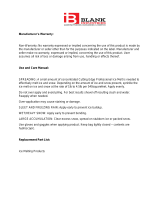
7
SNOW BLOWER SAFETY WARNINGS
OPERATING ENVIRONMENT
1. Using a snow blower indoors can kill you in min-
utes. Only use a snow blower outside and far away from
windows, doors and vents.
2. Do not smoke near the snow blower.
3. Do not operate near open flame, heat, or flamma-
ble materials. This snow blower may emit highly flam-
mable and explosive gasoline vapors, which can cause
severe burns or even death if ignited. A nearby open
flame can lead to an explosion even if it isn’t directly in
contact with gasoline.
4. Thoroughly inspect the area where the snow blower
is to be used. Remove all doormats, newspapers, sleds,
boards, wires, extension cords, or any other foreign ob-
jects. Such objects pose a tripping hazard, or could be
thrown by the auger.
5. Maintain distance between the snow blower and
bystanders. Keep at least 75 feet away from bystand-
ers, pets, children, etc. Stop the machine if anyone en-
ters this area.
6. Thrown objects can cause serious personal injury.
Plan your snowblowing pattern to avoid discharge of
material towards roads, bystanders, windows, walls,
cars, etc.
7. Exercise caution to avoid slipping or falling, es-
pecially when operating in reverse. Wear appropriate
footwear.
8. Wear appropriate clothing for the weather condi-
tions. Wear ANSI Z87.1-approved eye protection, with
side shields, at all times. Do not wear jewelry, long
scarves, or loose clothing – these can become entan-
gled in moving parts. Wear hearing protection.
TRAINING
1. Read, understand, and follow all instructions on
your snow blower’s labels, as well as those contained
in this manual, before attempting to assemble, oper-
ate, maintain, or otherwise use your machine. Keep this
manual in a safe place and refer to it regularly. Ensure all
users of the machine are properly trained.
2. Familiarize yourself with all controls and their
proper operation. Know how to stop the machine and
disengage the controls quickly.
3. Do not allow children under 14 years old, or any
non-qualified person, to operate the machine. All op-
erators must be properly trained in the safe use of this
machine and follow all instructions on the machine and
in this manual. Children 14 years or older should be su-
pervised by a trained adult.
SNOW BLOWER PREPARATION
1. Do not overfill fuel tank, as gasoline may expand
during operation. Do not fill to the very top of the tank.
Leave room for gasoline expansion. Always check for
spilled fuel before operating.
2. If any part of the snow blower is broken, damaged,
or defective, make sure it is repaired or replaced be-
fore operation. Service should only be performed by a
qualified technician.
3. Never modify the snow blower in any way. Modi-
fying or using the machine for any other purpose for
which it is not designed may result in serious injuries,
machine damage and voiding of the warranty.
4. If using the electric start function, ensure the exten-
sion cord is rated for outdoor use. Use only a grounded
three-wire extension cord and receptacle. A GFCI outlet
is recommended to maximize safety.
Snow blower safety warnings continue
on the next page.
WARNING! Do not let comfort or familiarity with the product replace strict adherence to product safety
rules. Failure to follow the safety instructions may result in serious personal injury.





















